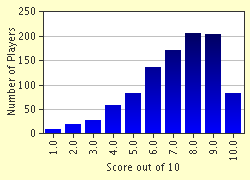Quiz Answer Key and Fun Facts
1. Let's start with a basic outline of the structure of an animal cell. You know that the shape, size and functions of all eukaryotic cells (there are 2 types of cells, prokaryotic and eukaryotic, out of which in this quiz you needn't bother about prokaryotic cells) varies, yet they all have three main functional regions, namely the plasma membrane, nucleus and cytoplasm.
What is the name given to the nucleus and cytoplasm of a cell combined?
2. The plasma membrane is the outer covering of every cell, which separates its contents from everything around it. It provides a mechanical barrier for the protection of the inner cell contents. It is said to be "selectively permeable". What does this mean?
3. The nucleus is a prominent spherical or oval structure, located usually near the centre of the cell. It is the "control centre" of all cell activities. Which of the following do *NOT* form a part of the nucleus of a eukaryotic animal cell?
4. Endoplasmic reticulum (ER) is a membranous network present in cells, which encloses a fluid-filled lumen. It is of two types: rough endoplasmic reticulum, which has ribosomes (another type of cell organelle) attached to it, and smooth endoplasmic reticulum, which doesn't have ribosomes.
Now state if the following statement is 'true' or if it is 'false': Rough ER is involved in synthesizing proteins whereas smooth ER synthesizes lipids.
5. This cell organelle packages material synthesized in the ER and dispatches it to targets both intracellular and extracellular. It is also involved in the formation of lysosomes and peroxisomes. It was discovered by an Italian anatomist in the late 19th century.
This cell organelle is called _____ apparatus/complex/body.
6. These are small membrane-bound sacs containing powerful oxidative enzymes. They are specialized for carrying out oxidative reactions, which include the removal of toxic substances. They are mostly found in kidney and liver cells. Which cell organelles are these?
7. Mitochondria are rod-shaped organelles, bordered by a double membrane. The outer membrane is smooth and the inner one is folded. What are these finger-like folds called?
8. These cell organelles contain enzymes for cellular respiration in which energy is released. Energy from consumed food molecules is converted into usable energy, stored as ATP (adenosine triphosphate) molecules. These organelles are hence called 'power plants' of the cell. Which cell organelles am I talking about?
9. This cell organelle consists of two granule-like centrioles and is found in animal cells only. It helps in cell division. What is it called?
10. These are membrane-bound vesicles and are present in plenty in every cell. They contain powerful enzymes capable of either digesting or breaking down all organic material. They are called "digestive bags", because they serve as an intracellular digestive system, i.e. a mini-digestive system within the cell. They destroy any foreign material that manages to make it it inside the cell, such as bacteria, etc. They also remove worn-out or poorly functioning organelles from the cell. They may even sometimes digest the entire damaged or dead cells containing them, hence the second nick-name - "suicide bags".
What are these cell organelles?
Source: Author
achernar
This quiz was reviewed by FunTrivia editor
crisw before going online.
Any errors found in FunTrivia content are routinely corrected through our feedback system.

